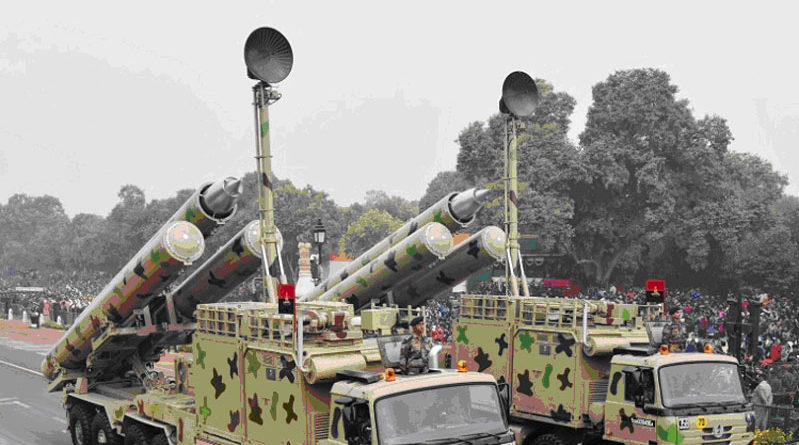Russia Day 2021: BRAHMOS – Redefining Indian Military Strength And Future Battlefield
12 June 2021
The BRAHMOS Joint Venture (JV), a unique role-model between India’s Defence Research & Development Organisation (DRDO) and Russia’s JSC MIC NPO Mashinostroyeniya (NPOM), has today become a shining example of Indian-Russian military and technological cooperation
At a time when India is evolving as a great power, economically as well as militarily, the country has gained immense expertise in designing and developing state-of-the-art defence systems. This accomplishment has made it enter into an elite club of powerful nations at the global stage having the capability to build their own military platforms and systems. A perfect emblem of India’s growing military might is the BRAHMOS supersonic cruise missile system.
BRAHMOS supersonic cruise missile has been indomitably scaling greater heights of success since its inception in 1998. The journey of BRAHMOS Joint Venture started on February 12, 1998 after the landmark signing of the Inter-Governmental Agreement at Moscow, by the Government of India and Government of Russia. Since its historic maiden launch on June 12, 2001, the BRAHMOS supersonic cruise missile system has charted many milestones and strengthened all three services of the Indian Armed Forces.
The BRAHMOS Joint Venture (JV), a unique role-model between India’s Defence Research & Development Organisation (DRDO) and Russia’s JSC MIC NPO Mashinostroyeniya (NPOM), has today become a shining example of Indian-Russian military and technological cooperation. The supersonic cruise missile with its multi-role capability, universality and utmost lethality, has carved a distinct place for itself in the Indian Armed Forces. The weapon stands out as the only universal supersonic cruise missile system in the whole world with the capability of neutralising land or sea-based targets.
BRAHMOS, initially conceived and developed as an anti-ship cruise missile (ASCM) system, has evolved over the years and added many more variants — from sea-to-land, sea-to-sea, land-to-land, land-to-sea, sub-sea-to-land, sub-sea to sea and air-to-land configurations. The universal missile can be fired either from static, mobile platforms (land and sea) or fighter aircraft, in solo or salvo mode. This multiplicity makes the weapon all the more versatile in taking on the enemy anywhere, anytime.
Indian Army, which became the first land force in the world to deploy the deadly BRAHMOS supersonic cruise missile in 2007, has raised several regiments of the formidable weapon in different configurations the latest being the “near vertical dive” trait to strike down an enemy target from a 90-degree angle. Similarly, for many of the Navy’s frontline surface ships, BRAHMOS has been deployed as a prime strike weapon. In its sub-sea launch configuration, the supersonic cruise missile is set to increase the Navy’s underwater weapons delivery capability manifold by being armed in the future submarines. The Indian Air Force’s (IAF) frontline fighter aircraft Sukhoi-30MKI, after being modified to carry 2.5 tonne missile integrated with half a ton launcher, has successfully demonstrated BRAHMOS missile’s firing capability. The successful induction of BRAHMOS in all the three services has made India the first and only country in the world to complete the “supersonic cruise missile triad”.
In its pledge to the Atmanirbhar Bharat mission, BRAHMOS has achieved historic milestones in the flagship ‘Make In India’ programme. It has successfully indigenise major sub-systems such as Airframe, solid propellant propulsion system, nose cap, canister, fuel management system and other major non-metallic airframe components taking the Indian contribution to approximately seventy percent. All launcher systems for the weapon are also being manufactured domestically. 100% of ground support equipment for the weapon complex are also being made in India.
BRAHMOS Aerospace also possesses a full-fledged design centre, a Missile Industrial Consortium for producing different sub-systems, a world-class integration, and check-out facilities with stringent quality control, which involves over 200 small and medium Indian public and private defence sector enterprises and institutions. BRAHMOS, today, employs nearly 20,000 workforce, technical and non-technical, directly and indirectly, who have been the real backbone of this successful defence programme of India.
BRAHMOS Aerospace now aims to take it to the next level by designing and developing even more lethal and powerful variants of the existing weapon, including a smaller, smarter BRAHMOS-NG (Next-Gen) for arming a wide range of modern military platforms.
The supersonic cruise missile is armed with a fine combination of speed, precision and power. The multi-platform, multi-target cruise missile, carrying a conventional warhead, is capable of flying up to 290-km at a top speed of around Mach 3. The supersonic speed with manoeuvrable trajectory makes it invincible for interception by the enemy’s air defence system.
Possession of such a weapon system with a distinct capability to strike down and annihilate all types of enemy targets at different locations and in different surroundings is a major advantage. The Indian Armed Forces takes pride in being the first in the world to possess the BRAHMOS supersonic cruise missiles with advanced surgical-strike capabilities.
Courtesy: Free Press Journal

